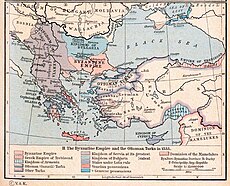
Back هجرات الصرب الكبرى Arabic Голямо сръбско преселение Bulgarian Migracions sèrbies Catalan Stěhování Srbů Czech Grandes migraciones serbias Spanish Serbien maastamuutot Finnish Migrations serbes French Nagy szerb kivándorlás Hungarian Սերբերի մեծ արտագաղթ Armenian Migrasi Besar Serbia ID
| History of Serbia |
|---|
 |
|
|

The Great Migrations of the Serbs (Serbian: Велике сеобе Срба, romanized: Velike seobe Srba), also known as the Great Exoduses of the Serbs,[1] were two migrations of Serbs from various territories under the rule of the Ottoman Empire to the Kingdom of Hungary under the Habsburg monarchy.[2][3]
The First Great Migration occurred during the Habsburg-Ottoman War of 1683–1699 under Serbian Patriarch Arsenije III Crnojević as a result of the Habsburg retreat and the Ottoman reoccupation of southern Serbian regions, which were temporarily held by the Habsburgs between 1688 and 1690.[4]
The Second Great Migration took place during the Habsburg-Ottoman War of 1737–1739, under the Serbian Patriarch Arsenije IV Jovanović, also parallel with the Habsburg withdrawal from Serbian regions; between 1718 and 1739, these regions were known as the Kingdom of Serbia.[5]
The masses of earlier migrations from the Ottoman Empire are considered ethnically Serb, and those of the First Great Migration nationally Serb. The First Great Migration brought about the definitive indicator of Serbianness, Orthodox Christianity and its leader, the patriarch.[6]
- ^ Mohareb, Nabil; Cardaci, Alessio; Maruthaveeran, Sreetheran; Cavalagli, Nicola (29 July 2022). Cities' Identity Through Architecture and Arts. Springer Nature. p. 201. ISBN 978-3-030-99480-8.
- ^ Ćirković 2004, p. 143-148, 153–154.
- ^ Гавриловић 2014, p. 139–148.
- ^ Ćirković 2004, p. 143-148.
- ^ Ćirković 2004, p. 153-154.
- ^ Nicholas J. Miller (15 February 1998). Between Nation and State: Serbian Politics in Croatia Before the First World War. University of Pittsburgh Pre. p. 13. ISBN 978-0-8229-7722-3.
© MMXXIII Rich X Search. We shall prevail. All rights reserved. Rich X Search